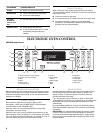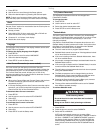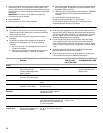
16
3. Gently close the door until the spacer magnet makes contact
with the oven door. The magnet will hold the spacer in the
proper position during the drying process and allows the door
to be opened at any time during drying without losing proper
positioning.
IMPORTANT: If the spacer is not placed correctly, the
convection fan will not operate.
4. Press CONVECT.
5. Press the arrow to scroll to select DRYING.
6. Select a displayed temperature or enter a temperature with
the number pads. Temperatures can be set between 100°F
and 200°F (38°C and 93°C).
7. “DRYING” and the temperature will be displayed. “PREHEAT”
will be displayed until the programmed temperature is
reached.
8. Press CANCEL when finished drying.
Follow the Drying Guide chart for drying times.
Check foods at minimum times given. Cool foods to room
temperature before testing for doneness
DRYING GUIDE CHART.
■ The length of drying times vary due to water and sugar
content of food, size of food pieces, amount of food being
dried, humidity in the air.
■ Check foods at the minimum drying time. Dry longer if
necessary.
■ Fruits that turn brown when exposed to air should be
treated with an antioxidant. Try one of the following
methods:
1. Dip fruit in a mixture of 3 tablespoons lemon juice to
1 quart of cool water.
2. Soak fruit in a solution of 1 teaspoon ascorbic acid or
commercial antioxidant to 1 quart of cold water.
■ Most fruits and vegetables dry well and retain their color when
dried at 140°F (60°C). Meat and jerky should be dried between
145°F and 150°F (63°C and 65°C). For optimal flavor, dry herbs
at 100°F (38°C), however, at this lower temperature expect
extended drying times of up to 8 hours.
■ Foods may drip during the drying process. After drying high
acid or sugary foods, clean the oven bottom with soap and
water. The porcelain oven finish may discolor if acidic or sugary
food soils are not wiped up prior to high heat or a self-cleaning
cycle.
■ More than one rack of food may be dried at the same time.
However, additional drying time is needed.
■ Refer to other resources at your local library or call your local
County Extension service for additional information
FOOD VARIETIES BEST FOR
DRYING
PREPARATION APPROX. DRY
TIME AT 140°F
(60°C) [HOURS]**
TEST FOR DONENESS
AT MINIMUM DRY TIME
FRUIT
Apples* Firm varieties: Graven
Stein, Granny Smith,
Jonathan, Winesapp, Rome
Beauty, Newton
Wash, peel if desired, core and
slice into ¹⁄₈" (3.0 mm) slices.
4 to 8 Pliable to crisp. Dried
apples store best when
slightly crisp.
Apricots* Blenheim/Royal most
common. Tilton also good.
Wash, halve, and remove pits. 18 to 24 Soft and pliable
Bananas* Firm varieties Peel and cut into ¼" (6.0 mm)
slices.
17 to 24 Pliable to crisp
Cherries Lambert, Royal Ann,
Napoleon, Van or Bing.
Wash and remove stems. Halve
and remove pits.
18 to 24 Pliable and leathery
Nectarines and
Peaches*
Freestone varieties. Halve and remove pits. Peeling is
optional but results in better-
looking dried fruit.
24 to 36 Pliable and leathery
Pears* Bartlett Peel, halve and core. 24 to 36 Soft and pliable
Pineapple Fresh or canned Wash peel and remove thorny
eyes. Slice lengthwise and remove
the small core. Cut crosswise into
½" (12.0 mm) slices.
Canned: 14 to 18
Fresh: 12 to 6
Soft and pliable
Orange and
Lemon peel
Select rough-skinned fruit.
Do not dry the peel of fruit
marked “color added.”
Wash well. Thinly peel the outer
¹⁄₁₆" to ¹⁄₈" (1.5 mm to 3.0 mm) of
the peel.
1 to 2 Tough to brittle


















